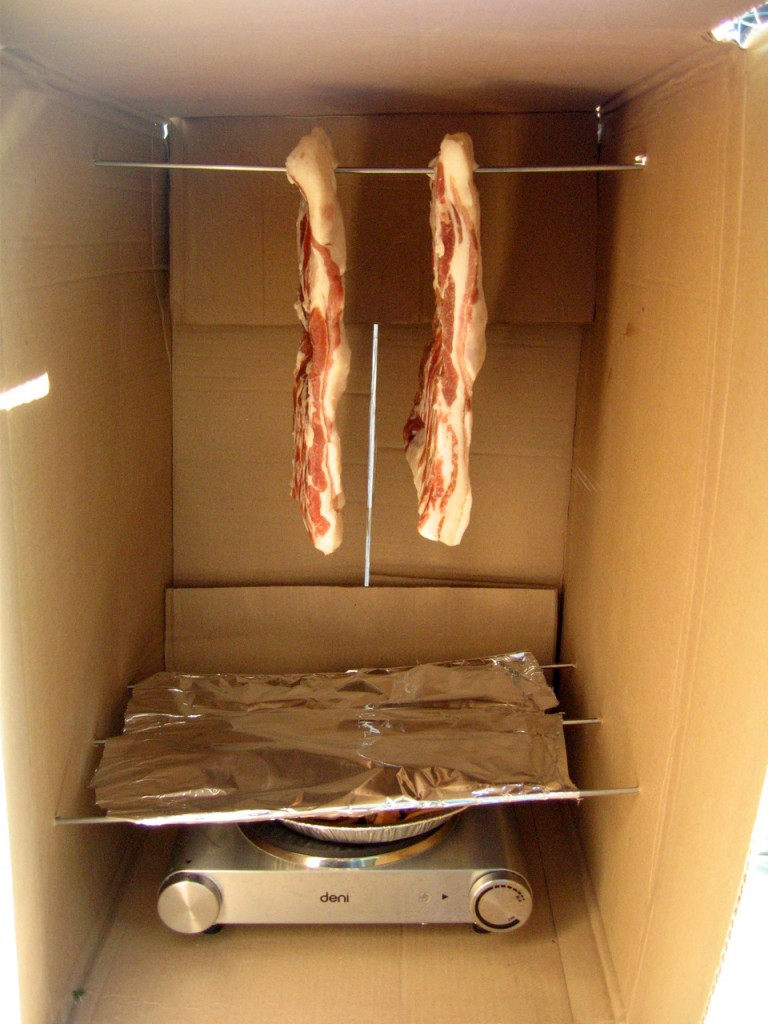
The Bacon Life
Ruben Anderson Published April 2013 Village Vibe NewspaperWe moved back to Victoria in 2011. Being closer to family was part of it, but we also sought a more richly meaningful life. We wanted to stop being a part of what Nicholas Georgescu-Roegen called, “the Circumdrome of the Shaving Machine, which is to shave oneself faster so as to have more time to work on a machine that shaves faster so as to have more time to work on a machine that shaves still faster, and so on…”
Now we spend a lot of our time—right here in Fernwood—growing, raising, making, curing, canning, drying, pickling, fermenting and eating our own food, and working on other parts of what we call The Small and Delicious Life. Today I want to share The Bacon Life. (Read the full article, with links and side notes, at smallanddeliciouslife.com).
We recently had a spontaneous bacon smackdown between our home-cured and smoked Vancouver Island pork, and the most expensive bacon at the grocery store—and we are ruined for industrial bacon. The flavour was uninspiring and the texture unpleasant—kind of like chewing on a burnt cereal box.
We buy our pork belly from The Village Butcher in Oak Bay, where they put some work into finding meat from animals that lived relatively happy lives. One belly is actually just one half of a pig’s belly, and our last one was three and a half kilos. After making a couple of batches I started requesting bellies that are more meat and less fat—I think this last belly came from a Tamworth pig, which is leaner than a Berkshire. For now, ask the butcher to cut the skin off.
We follow a recipe from Charcuterie, by Michael Ruhlman—and crosscheck with our other meat-curing bible, Home Production of Quality Meats and Sausages, by Stanley and Adam Marianski. Charcuterie is more of a recipe and coffee-table book—better for dabblers—while the Marianski book gives comprehensive principles for the home meatsmith to safely make their own recipes.
Bacon is simple. At the most basic you need only salt, and liquid smoke for flavour. However, the classic ‘cured-meat flavour’ and the pinkness of bacon is partly from curing with sodium nitrite. If the meat will age for a long time, like salami, sodium nitrate is used; the nitrate is converted to nitrite during aging. Both chemicals come mixed approximately 20:1 with salt for easier measurement and are sold under several names—Pink Salt, Prague Powder, Curing Salt, etc. Nitrite is Cure #1 and nitrate is Cure #2.
We try to avoid chemical agriculture so I did a lot of research on nitrites and nitrates. Some places use things like celery juice to cure bacon ‘naturally’—and apparently celery juice contains enormous amounts of naturally occurring sodium nitrate. So, I use the curing salts.

Buy Ruhlman’s book to get the variations on his recipes, but first he would have you mix up a ‘Basic Dry Cure’ (use a good scale):
450 grams/ 1lb kosher salt
225 grams/ 8 oz sugar
50 grams/ 2 oz pink salt (cure #1, nitrite—available at the Homesteader’s Emporium in Vancouver for $7/lb)
Then cut your belly into pieces that will fit into a large ziploc bag—this belly needed three bags. As long as the piece of meat weighs between three and five pounds, just sprinkle ¼ cup of the basic dry cure on each piece (both sides, and rub it around to coat evenly).
Now seal the bags and refrigerate for 7-10 days. Flip the bags over every two days to redistribute the salty liquid that forms. The meat is cured when it feels firm, not soft. Poke it when you put it in the fridge and try to remember how soft it felt, then compare a week later.
When the belly is firm, rinse the cure off and let the meat dry on a rack in the fridge for a day. This allows a tacky surface called a pellicle to form, which will help your smoke stick to it.
My first smoking was done in a cardboard box. Stalk your neighbourhood on recycling day and find a nice crisp box, about 18 inches square and two feet tall. I found a hotplate at the thrift shop for ten bucks, which goes inside the box. Put an aluminum pie plate (recycling day) with a cup of dry hickory chips (Canadian Tire, six bucks) on the hot plate.
Fold a little tent out of foil to cover the hotplate and pie plate—you don’t want any hot fat dripping on a hotplate inside a cardboard box, now do you?
Maybe this is a good time to say, do this outside? With a fire extinguisher handy? But remember paper burns at 451°F, so don’t panic.
Hang your meat (reinforce the box with duct tape and dowels as needed), crank the hotplate to high and use packing tape (not masking) to close the box. It should take about 30 minutes for smoke to start leaking out, after which you smoke for three hours. When the smoke tapers off, cut your box open and add more chips—three cups should do you for three hours. Don’t get too fussy at this stage—your first batch may not be perfect, but it will probably be the best bacon you have ever had.
After three hours take the bacon out and test the internal temperature. It needs to be 65°C/150°F. If it is not, put it in the oven and bring it up to that temp.
Let it cool, then freeze it. Then thaw it a little bit—when the bacon is still a little frozen the fat is easier to cut.Use a very sharp and slender knife, or an electric carving knife (thrift shop, ten bucks) to slice the bacon into rashers. Portion enough for a family breakfast out on sheets of wax paper before freezing again. Keep all the uneven bits for pea soup or rainy days.
Enjoy the Small and Delicious Life!
© Copyright 2013






Leave A Comment